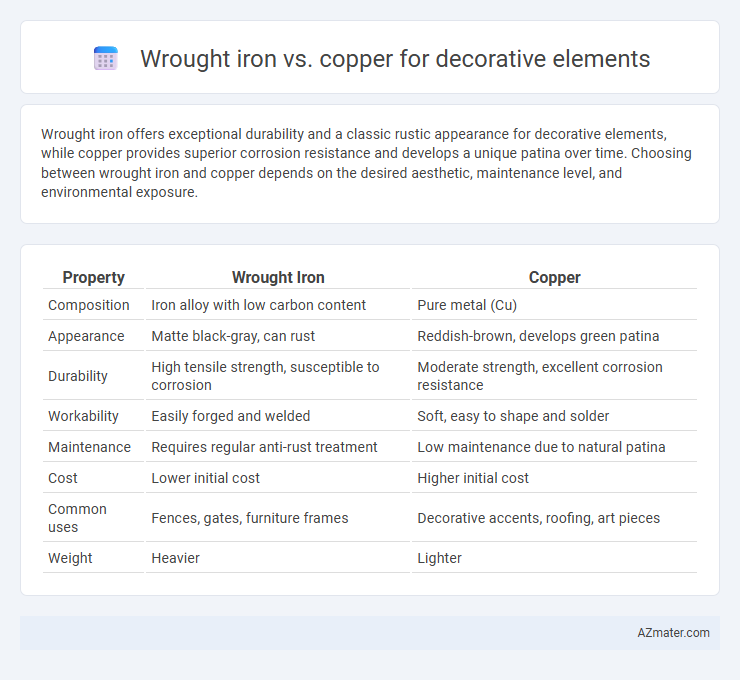Wrought iron offers exceptional durability and a classic rustic appearance for decorative elements, while copper provides superior corrosion resistance and develops a unique patina over time. Choosing between wrought iron and copper depends on the desired aesthetic, maintenance level, and environmental exposure.
Table of Comparison
| Property | Wrought Iron | Copper |
|---|---|---|
| Composition | Iron alloy with low carbon content | Pure metal (Cu) |
| Appearance | Matte black-gray, can rust | Reddish-brown, develops green patina |
| Durability | High tensile strength, susceptible to corrosion | Moderate strength, excellent corrosion resistance |
| Workability | Easily forged and welded | Soft, easy to shape and solder |
| Maintenance | Requires regular anti-rust treatment | Low maintenance due to natural patina |
| Cost | Lower initial cost | Higher initial cost |
| Common uses | Fences, gates, furniture frames | Decorative accents, roofing, art pieces |
| Weight | Heavier | Lighter |
Introduction to Wrought Iron and Copper in Decorative Design
Wrought iron and copper serve distinct roles in decorative design, with wrought iron prized for its durability, malleability, and classic blacksmith craftsmanship that creates intricate, timeless patterns. Copper offers a unique aesthetic with its warm, reddish hue and develops a natural patina over time, adding character and evolving color to design elements. Both materials enhance decorative pieces, but their choice depends on desired visual impact, weathering properties, and maintenance considerations in architectural and artistic applications.
Historical Use of Wrought Iron and Copper
Wrought iron has been historically valued for its durability and malleability, making it a popular choice in decorative elements such as gates, railings, and furniture since the Middle Ages. Copper, prized for its natural antimicrobial properties and lustrous appearance, was widely used in ancient architectural details and ornamental pieces, especially in Egyptian and Roman cultures. Both materials exhibit a rich heritage in design, with wrought iron favored for structural ornamental work and copper for intricate, visually striking accents.
Aesthetic Appeal: Visual Differences
Wrought iron features a classic, rustic aesthetic with intricate, handcrafted patterns and a matte, dark finish that enhances traditional and vintage decor styles. Copper offers a warm, shiny, and smooth surface that develops a unique patina over time, creating an elegant and contemporary look ideal for modern and artistic designs. The choice between wrought iron and copper for decorative elements significantly impacts visual appeal due to their distinct textures, colors, and aging processes.
Durability and Longevity Comparison
Wrought iron offers exceptional durability and longevity due to its high tensile strength and resistance to wear, making it ideal for outdoor decorative elements subjected to harsh weather conditions. Copper, while less hard than wrought iron, excels in corrosion resistance and develops a protective patina over time that enhances its lifespan and aesthetic appeal. Both materials provide long-lasting decorative value, but wrought iron withstands physical stress better, whereas copper's natural oxidation process ensures extended protection against environmental damage.
Maintenance Requirements for Wrought Iron and Copper
Wrought iron requires regular maintenance to prevent rust, including periodic cleaning, sanding off corrosion, and applying protective coatings like paint or sealant. Copper is more resistant to corrosion but develops a natural patina over time, requiring occasional cleaning to maintain its bright appearance. Both materials demand specific upkeep to ensure longevity and preserve their decorative qualities in outdoor or indoor settings.
Versatility in Design Applications
Wrought iron offers unparalleled versatility in design with its malleability, allowing intricate patterns and robust structural elements ideal for gates, railings, and furniture. Copper stands out for its unique aesthetic appeal and natural patina, making it a preferred choice for decorative accents, roofing, and sculptures that require a warm, metallic finish. Both materials complement various architectural styles, but wrought iron excels in weight-bearing designs, whereas copper is favored for lightweight, ornamental applications.
Cost Analysis: Wrought Iron vs Copper
Wrought iron typically costs significantly less than copper, making it a more budget-friendly option for decorative elements. Copper's higher price is driven by its superior corrosion resistance and aesthetic appeal, often justifying the additional expense for long-term value. When considering maintenance and durability, wrought iron may require more frequent upkeep, potentially increasing overall costs compared to copper.
Environmental Impact and Sustainability
Wrought iron offers high durability and recyclability, making it a sustainable option with a lower environmental footprint compared to copper, which requires intensive mining and refining processes that produce significant emissions. Copper, although recyclable, often entails greater energy consumption and habitat disruption during extraction, impacting its environmental viability. Choosing wrought iron for decorative elements supports eco-friendly construction by minimizing resource depletion and promoting long-term material reuse.
Customization and Craftsmanship
Wrought iron offers extensive customization with intricate designs achievable through traditional blacksmithing techniques, allowing for highly detailed and durable decorative elements. Copper provides unique craftsmanship opportunities by enabling artisans to create smooth, malleable shapes with a distinct warm patina that develops over time. Both materials showcase exceptional artisanal skill but differ in finish and flexibility, with wrought iron excelling in structural ornamentation and copper favored for elegant, fluid forms.
Choosing the Right Material for Your Decorative Project
Wrought iron offers durability and classic appeal for decorative elements, enhancing outdoor and indoor aesthetics with its strength and intricate designs. Copper provides a warm, natural patina over time, ideal for accents that benefit from corrosion resistance and a unique, evolving look. Selecting between wrought iron and copper depends on factors like desired longevity, maintenance, environmental exposure, and the specific artistic style of your decorative project.

Infographic: Wrought iron vs Copper for Decorative element
 azmater.com
azmater.com